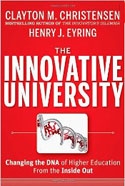
Continuing my thoughts from my last post on The Innovative University, Christensen and Eyring thoroughly describe the history and development of two very different private institutions: Harvard University and Brigham Young University (BYU)-Idaho (formerly Ricks College).


According to the authors, Harvard University has hands down become the traditional model for most of higher education. BYU-Idaho has become a recognized innovator, offering a disruptive model of higher education.
First, what is “disruption”?
Based on Christensen’s research in a number of fields, disruption occurs under  two major conditions: “growth in the number of would-be consumers who cannot afford the continuously enhanced offerings [in a given product segment] and thus become non-consumers. [And] the emergence of technologies that will, in the right hands, allow new competitors to serve this disenfranchised group of non-consumers” (p.
two major conditions: “growth in the number of would-be consumers who cannot afford the continuously enhanced offerings [in a given product segment] and thus become non-consumers. [And] the emergence of technologies that will, in the right hands, allow new competitors to serve this disenfranchised group of non-consumers” (p.  16) Classic examples include transistors that entered the market through cheap radios and personal computers that got their start through a low-end, amateur market segment. Both technologies eventually came to dominate their respective markets.
16) Classic examples include transistors that entered the market through cheap radios and personal computers that got their start through a low-end, amateur market segment. Both technologies eventually came to dominate their respective markets.
Circling back to higher education, Christensen and Eyring proposed the following elements they believe define the traditional model of higher education(e.g. “Harvard model”) adhered to or emulated by most postsecondary institutions (p. 136):
- Face-to-face instruction
- Specialization/departmentalization
- Long summer recess
- Graduate program dominance
- Private fundraising
- Competitive athletics
- General education and majors
- Academic honors
- Tenure and rank for faculty
- Admission selectivity
Specialization, selectivity, and many extracurricular amenities contribute to high cost. As institutions seek to move up the higher education classification system (e.g., community colleges that begin to offer four-year degrees or regional comprehensive institutions that strive to become research universities), costs continue to increase.
In conrast, some elements of Christensen’s and Eyring’s “disruptive model” of higher education include (p. 308, 322):
- Full year-round operation
- Modular majors
- Online courses and degrees
- Higher compensation and term contracts for faculty
- Broader definition of faculty scholarship with teaching emphasis
- Metrics related to desired outcomes (e.g. graduation rates, cost per student)
- Increased enrollments and access
- Reduced campus amenities
- Lower cost
These elements have been integrated at BYU-Idaho with positive results. (We should acknowledge that BYU-Idaho is owned by a large religious institution that can dictate changes to a large degree. It may be more challenging to fully implement these ideas elsewhere.)
Some of us may recognize many of these elements exist in programs offered by for-profit educational institutions. These providers serve formerly non-consumers of higher education, adults who were not able to access traditional higher education for one reason or another. Disruptive innovation in action. (With recent scrutiny and negative reports of many for-profit institutions, unfortunately many of these elements may become suspect in and of themselves.)
I do not believe it’s an either/or formula: traditional or disruptive.
And “one size” does not necessarily fit each and every institution. Institutional diversity is a major strength of U.S. higher education and should continue.
The main take home message from the book: In what ways might these two lists of elements foster a robust dialogue and offer tangible actions (taken as a whole or more likely in components) that could lead to high quality, high accessibility and holding the line or decreasing cost in higher education?
More to come in a future post.















